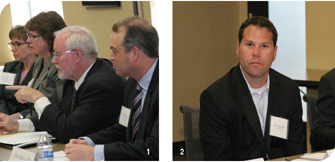
1. Flanked by co-chairs Dana Abraham and Matt Melton, moderator Dennis Boone asked a follow-up question about investor attitudes. | 2. Nick Karabas cited the need for wealth managers to provide the kind of objective device that becomes a foundation for investors’ financial plans.
Scott Fletcher said the benefit of running multiple plans for clients is the education they derive from the process. “There’s no one plan that’s going to come true in 30 years,” he said, “but showing them that with and without Social Security, with longevity at different rates, somebody knows what happens if they do live for 30 years into retirement and don’t have Social Security.”
Again, though, Ken Eaton noted, frequent consultations with clients help avoid the long-term train wrecks and surprises. “You don’t do it one time and let them go on about their business for 10 years, because they’re going to have three kids in the meantime; there are always different things that are changing all the time.”
An Industry in Transition
Multiple factors, participants said, are transforming the industry many have known for three decades or more. Among those are technology, which Scott Holsopple said was allowing a level of client service previously unknown to those below the highest levels of personal wealth.
“Technology presents a great opportunity,” he said. “As we bring more technology in, we become more efficient, and that lets us expand services traditionally reserved for the high-net worth client. Now you have the ability to do some of the more in-depth planning with some lower balances.” The Mutual Fund Store’s embrace of centralized research teams, he said, was made possible by technology, and can serve advisers nationwide.
“You can get a lot more done with fewer people and fewer resources, and that’s huge,” said Scott Fletcher. “And where you see challenges in this industry, you’d better be smart enough to see that as an opportunity, as well.” Considering the wealth transfer that will take place over the next 35 years, he said, much was at stake—roughly $18 trillion in assets now held by the Greatest Generation and the Baby Boomers.
That will make finding clients among a smaller Gen X investor class crucial. “There are studies that say around 17 percent of people who inherit wealth will use the same adviser their parents used,” Fletcher said. “That is certainly a challenge, but also an opportunity.
Another industry challenge is the age of financial advisers; Bob Rippy estimated that the average was now in the mid-50s, and Dana Abraham noted the vital role that the delivery team provides in retaining and recruiting clients—those team members often need to look like the prospective clients, she said.
A final challenge is declining numbers of professional planners. While that trend is matching up for now with a smaller investor pool expected over the long term, the potential for technology to bring services to many more smaller investors would bolster demand for trained manpower. Some of that need is being met with college-level courses tailored to financial planning certification, and some, as Abraham half-jested, by those in the room “stealing talent from each other.”
Overall, she said, the things that prudent wealth managers are doing now “put us in a better position to retain more than 17 percent” of the client base in the parent-child dynamic cited by Fletcher
Return to Ingram's August 2013